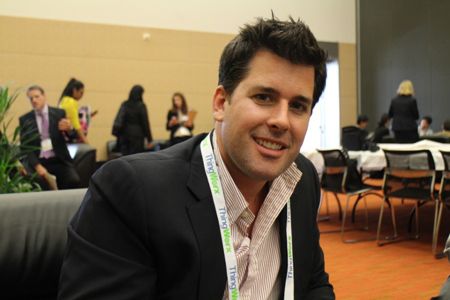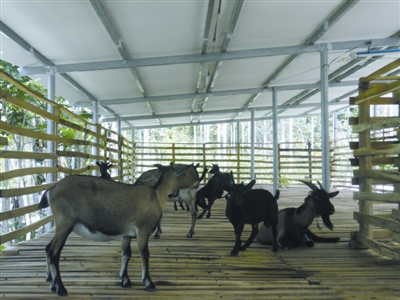Viewing the Entrepreneurial thinking of the Internet of things from big data's cattle raising
Brian Walsh, 36, looks cool, but appearance is nothing compared to what he does. Wolsey, the CEO and co-founder of Vital Herd,Inc., is tracking the health and dynamics of each cow around the clock through the Internet of things to help breeders improve the quality and yield of milk and beef. At the PTC Global user Conference in Boston, I interviewed the entrepreneurs who pioneered this strange business.
"at present, people's health and nutrition management of most livestock are judged by daily naked eye observation and experience. This is a very inefficient method because it is difficult and costly to correct when a problem is found. " Wolsey said.

Raising cattle and looking at the entrepreneurial thinking of the Internet of things "/ >
The practice of the Life and death Animal Husbandry Company is to make the cow swallow a 4.5-inch-long "electronic pill" (ePill) integrated with various sensors, chips and communication systems. The "electronic pill" enters the cow's "rumen" (the first and largest of the four stomachs of ruminants, the main function is to temporarily store feed and microbial fermentation), and thus begin to continuously track all kinds of life information of cattle. Including heartbeat frequency, body temperature, ruminating time, gastric acid concentration, hormone secretion and so on.
These life information are transmitted to nearby information receivers by microwave and sent to the cloud platform for data analysis and processing. According to certain standards, people can check the signs of cattle anytime and anywhere through terminal equipment, and any tracked cow will give an alarm if there is an abnormal system. On the basis of big data's analysis, people can even predict the behavior of cattle, so that breeders can improve feeding, disease prevention and management.
The first product currently being developed by Life and death Animal Husbandry is aimed at dairy producers, which will eventually help producers improve the quality and output of milk by tracking cows. "We expect to complete the final phase of testing in the second half of this year and put it into commercial operation by the end of the year, and our business in the dairy industry will be fully rolled out next year," Wolsey revealed. Since the establishment of the company in April 2012, life and death animal husbandry has accumulated about $1.3 million in angel investment. "our previous survey of thousands of dairy manufacturers showed that more than 90% of the respondents were very interested in our services."
If the business develops as Wolsey expects, life and death animal husbandry companies will enter a big market with broad prospects. According to a report by the United States Department of Agriculture, nearly 4 million animals die in dairy meat production in the United States each year, and a higher number of animals get sick. This means that American dairy meat producers suffer billions of dollars in economic losses each year, including lost income, extremely high treatment costs and feeding costs-billions of dollars in losses that provide room for life-and-death livestock companies.
"We will be the first software service company in the world to really start monitoring cattle on a large scale, and unlike previous research institutions that have tried this field in the past, we can make the cost very low, even up to the previous 1max 20," Wolsey said. "for dairy producers, they just have to pay a service subscription fee of dozens of dollars a year for each tracked cow."
Wolsey's groundbreaking business story not only brought a lot of fun to the audience, including me, but also caused me to think about the start-up of the Internet of things.
First, the era of the Internet of things may provide entrepreneurs with the possibility to create unprecedented product innovation, which is characterized by a combination of sensors and chips. There is no doubt that the "electronic pill", the core of the Livestock Company of Life and death, is a groundbreaking product. The technology, invented by Wolsey's partner, was once used by the US military and has since been spun off due to a lack of investment projects, thus creating a life-and-death livestock company.
"in the future, every object may be integrated into a chip, whether it's household appliances, large excavators, or even light bulbs," said Eric Snow, vice president of global communications at PTC. "this change will revolutionize the concept and way of product design and innovation, thus opening up a lot of opportunities for new entrants."
Second, the Internet of things entrepreneurship is no longer an independent behavior, compared with the traditional areas of entrepreneurship, it needs to unite, use more ecological resources and adopt more open innovation. Take the Life and death Animal Husbandry Company as an example, the "electronic pill" integrated with sensing technology and communication technology is its core patent, and for big data to raise cattle can really help dairy producers, it is obviously not enough to rely on "electronic pills"-it will be a huge project, including software, communications, cloud platforms and data analysis.
"what we are good at is electronic pills, for startups, we are very flexible and fast, but we lack resources, so we have to focus, it is impossible to do it all. For other aspects of business, we have adopted the approach of cooperating and borrowing existing platforms. " Wolsey explained. Because of this, the Life and death Animal Husbandry Company, which has been founded for more than 2 years, is still a "light company". In addition to the two founding team members, more than 10 other members are temporary external experts set up according to the needs of the project. across software, communications, animal husbandry and other fields.
- Prev

Sichuan 300 million "red packet" helps college students start their own businesses and set up online stores to subsidize 10,000 yuan.
Sichuan 300 million "red packet" helps college students start their own businesses and set up online stores to subsidize 10,000 yuan.
- Next

Sanya provides farmers with more than 10 million yuan in subsidies to help the development of animal husbandry.
Sanya provides farmers with more than 10 million yuan in subsidies to help the development of animal husbandry.
Related
- A course of planting techniques and methods on how to grow carrots
- How to plant the latest tulips?
- Is it better to pick tea in the morning or in the afternoon? When is the best time for tea to be picked? what is the third or fifth tea?
- Launch Yuanxiao Happy combination Haocha + Tea Yuan healthy Taste
- Penghu Tourism "Fireworks 20 Parade with You"
- 2022 West Lake Happiness holds "Digital Revitalization Voucher" and draws iphone13 and laptop.
- Banqiao Fuzhou social houses are designed to change start-up combined with police elimination to create a safe and livable environment
- The convenient measure of "mechanical weeding" in Xinbei has been abused and the Agriculture Bureau has imposed heavy penalties on the illegal land consolidation.
- Changgeng University Joins Hands with Four Memory Factories to Rescue Memory Talent Shortage
- The list of Taiwan's top 100 MVP managers is listed by the Director-General of the Farmers' Association of Sanxia District.

